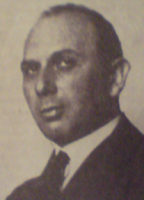
Abstract expressionism is a post–World War II art movement in American painting, developed in New York in the 1940s. It was the first specifically American movement to achieve international influence and put New York City at the center of the western art world, a role formerly filled by Paris. Although the term "abstract expressionism" was first applied to American art in 1946 by the art critic Robert Coates, it had been first used in Germany in 1919 in the magazine Der Sturm, regarding German Expressionism. In the United States, Alfred Barr was the first to use this term in 1929 in relation to works by Wassily Kandinsky.

Nikola Martinoski, sometimes spelled Martinovski (Macedonian: Никола Мартиноски), was a Yugoslav Aromanian painter. He is considered as a founder of contemporary Macedonian art. Martinoski is best known for his painting titled Mother with Child, which, although first created in the 1930s, was not completed until the 1960s. He is also known as "The Doctor" for the many paintings he donated to modern art.
Dimitar Avramovski–Pandilov is considered the first impressionist painter, the founder of modern Macedonian art. He died at the Skopje earthquake in 1963.

Dimitar Kondovski was a Macedonian painter, critic and professor.

Lazar Ličenoski. He was one of the first Slavic expressionist painters and one of the most authentic Macedonian painters of landscape, in which he imported folk elements as well. He painted still nature, portraits and mosaics.
Tomo Vladimirski (1904-1971) was a Macedonian painter, considered to be one of the founders of Macedonian painting.
Vangel Kodžoman was a Macedonian painter.

Lyrical abstraction is either of two related but distinct trends in Post-war Modernist painting:
Gligor Stefanov is a sculptor and environmental installations artist, who lives in Windsor, Ontario, Canada.
Petar Gligorovski was a Yugoslav and Macedonian academic painter and an animated movies director.
Borislav Traikovski (1917–1996) is a Macedonian painter. One of the most famous Macedonian painters, Borislav Traikovski was born on June 15, 1917 in Bitola.
Petar Hadzi Boskov was a Macedonian sculptor.

Oskar Herman (1886–1974) was a Croatian Jewish painter. He was one of the group of Croatian artists known as the Munich Circle, who had a strong influence on modern art in Croatia.
Janko Konstantinov, is a Macedonian architect and artist.

Marino Tartaglia was a Croatian painter and art teacher, for many years a professor at the Academy of Fine Arts, Zagreb.
Zlatko Šulentić (1893–1971) was a Croatian painter of landscapes and portraits.
Vilko Gecan was a Croatian painter, influential in the Zagreb modern art scene of the 1920s and 1930s. He is best known for his expressionist paintings and drawings, and for his contributions to the local avantgarde magazine Zenit. He showed his work in many solo and group exhibitions in Croatia and abroad. In the Zagreb Spring Salon of the 1920s, he participated with Milivoj Uzelac, Marijan Trepše and Vladimir Varlaj, who together were known as the "Group of Four" or "The Prague Four". Trained in Prague, works of these young painters brought new expressionist ideas that went on to dominate the 1920s Croatian art scene.
Ljubomir Belogaski was born on 15 April 1911 in Delčevo. He died on 15 February 1994 in Skopje.
Rubens Korubin is an artist based in Skopje.
Goran Menkov is a Macedonian visual artist. He holds a degree in painting at Ss. Cyril and Methodius University of Skopje, Faculty of Fine Arts, in the class of Professor Rubens Korubin.








